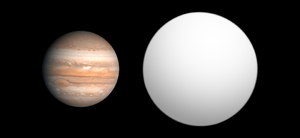- COROT-1b
-
COROT-1b[1][2] Extrasolar planet List of extrasolar planets 
Size comparison of COROT-1b with Jupiter. Parent star Star COROT-1[2] Constellation Monoceros Right ascension (α) 6h 48m 19.17s[3] Declination (δ) −3° 06′ 07.78″[3] Distance 1,560 ly
(480 pc)Spectral type G0V[2][3] Orbital elements Semimajor axis (a) 0.025±0.001[4] AU Eccentricity (e) ~0[3] Orbital period (P) 1.5089557±0.0000064[3] d (36.214936 h) Inclination (i) 85.1±0.5[3]° Time of transit (Tt) 2454159.4532±0.0001[3] JD Physical characteristics Mass (m) 1.03±0.12[3] MJ Radius (r) 1.49±0.08[3] RJ Density (ρ) 380±50[3] kg m-3 Surface gravity (g) 11.5[5] m/s² Temperature (T) 1,898±50[3] K Discovery information Discovery date 1 May 2007 Discoverer(s) Barge et al. Detection method Transit Discovery site  France
FranceDiscovery status Confirmed Other designations CoRoT-Exo-1bDatabase references Extrasolar Planets
Encyclopaediadata SIMBAD data COROT-1b[2] (previously named COROT-Exo-1b)[1] is an extrasolar planet approximately 1,560 light-years away in the constellation of Monoceros. The planet was discovered orbiting the yellow dwarf star COROT-1 in May 2007. The planet was the first discovery by the French-led COROT Mission.
Contents
Detection and discovery
The planet was announced by the COROT mission (a CNES project with European Space Agency participation). The planet is a large hot Jupiter, about 1.49 times the radius of Jupiter and approximately 1.03 times as massive, based on ground observations of the star. Its large size is due to its low density combined with the intense heating of its parent star causing the outer layers of the atmosphere to bloat.
Observation of phases
In May 2009 COROT-1b became the first extrasolar planet for which optical (as opposed to infrared) observations of phases were reported.[6] These observations suggest that there is not significant heat transfer between the (tidally locked) night and day sides of the planet.[7]
See also
Notes and references
- ^ a b Schneider, J. (2009-03-10). "Change in CoRoT planets names". Exoplanets mailing list. http://listes.obs.ujf-grenoble.fr/wws/arc/exoplanets/2009-03/msg00003.html. Retrieved 2009-03-19.
- ^ a b c d "Notes for planet CoRoT-1 b". http://exoplanet.eu/planet.php?p1=CoRoT-1&p2=b. Retrieved 2009-03-17.
- ^ a b c d e f g h i j k Barge et al.; Baglin, A.; Auvergne, M.; Rauer, H.; Léger, A.; Schneider, J.; Pont, F.; Aigrain, S. et al. (2008). "Transiting exoplanets from the CoRoT space mission. I. CoRoT-Exo-1b: a low-density short-period planet around a G0V star". Astronomy and Astrophysics 482 (3): L17–L20. Bibcode 2008A&A...482L..17B. doi:10.1051/0004-6361:200809353.
- ^ The paper gives the semimajor axis as 4.92 ± 0.08 times the radius of the star, which is estimated at 1.11 ± 0.05 solar radii
- ^ Calculated using Newtonian gravity:

- ^ Ignas A. G. Snellen; Ernst J. W. de Mooij; Simon Albrecht (2009-05-28). "The changing phases of extrasolar planet CoRoT-1b". Nature 459 (7246): 543–545. Bibcode 2009Natur.459..543S. doi:10.1038/nature08045. PMID 19478779. http://www.nature.com/nature/journal/v459/n7246/full/nature08045.html.
- ^ Andrea Thompson (2009-05-27). "Exoplanet Phases Seen in Optical Light". Space.com. http://www.space.com/scienceastronomy/090527-exoplanet-phases.html. Retrieved 2009-05-27.
External links
 Media related to COROT-1b at Wikimedia Commons
Media related to COROT-1b at Wikimedia Commons- "COROT discovers its first exoplanet and catches scientists by surprise". European Space Agency. 2007-05-03. http://www.esa.int/esaCP/SEMCKNU681F_index_0.html. Retrieved 2008-06-29.
- Morelle, Rebecca (2007-05-03). "Space telescope spots new planet". BBC News. http://news.bbc.co.uk/2/hi/science/nature/6611557.stm. Retrieved 2008-06-29.
Categories:- Extrasolar planets
- Hot Jupiters
- Monoceros constellation
- Transiting extrasolar planets
- Gas giant planets
- Exoplanets discovered in 2007
Wikimedia Foundation. 2010.

